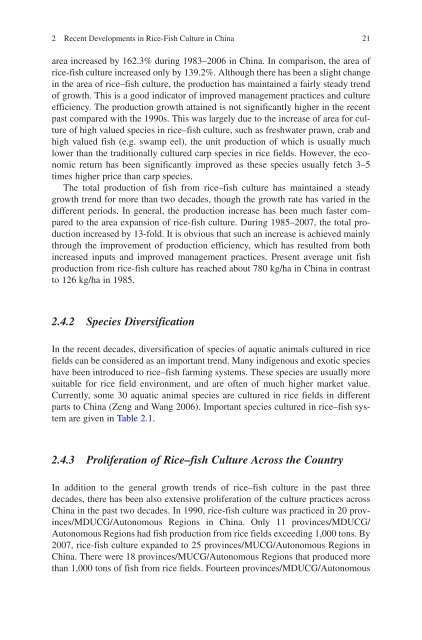Success Stories In Asian Aquaculture - Library - Network of ...
Success Stories In Asian Aquaculture - Library - Network of ...
Success Stories In Asian Aquaculture - Library - Network of ...
- No tags were found...
You also want an ePaper? Increase the reach of your titles
YUMPU automatically turns print PDFs into web optimized ePapers that Google loves.
2 Recent Developments in Rice-Fish Culture in China21area increased by 162.3% during 1983–2006 in China. <strong>In</strong> comparison, the area <strong>of</strong>rice-fish culture increased only by 139.2%. Although there has been a slight changein the area <strong>of</strong> rice–fish culture, the production has maintained a fairly steady trend<strong>of</strong> growth. This is a good indicator <strong>of</strong> improved management practices and cultureefficiency. The production growth attained is not significantly higher in the recentpast compared with the 1990s. This was largely due to the increase <strong>of</strong> area for culture<strong>of</strong> high valued species in rice–fish culture, such as freshwater prawn, crab andhigh valued fish (e.g. swamp eel), the unit production <strong>of</strong> which is usually muchlower than the traditionally cultured carp species in rice fields. However, the economicreturn has been significantly improved as these species usually fetch 3–5times higher price than carp species.The total production <strong>of</strong> fish from rice–fish culture has maintained a steadygrowth trend for more than two decades, though the growth rate has varied in thedifferent periods. <strong>In</strong> general, the production increase has been much faster comparedto the area expansion <strong>of</strong> rice-fish culture. During 1985–2007, the total productionincreased by 13-fold. It is obvious that such an increase is achieved mainlythrough the improvement <strong>of</strong> production efficiency, which has resulted from bothincreased inputs and improved management practices. Present average unit fishproduction from rice-fish culture has reached about 780 kg/ha in China in contrastto 126 kg/ha in 1985.2.4.2 Species Diversification<strong>In</strong> the recent decades, diversification <strong>of</strong> species <strong>of</strong> aquatic animals cultured in ricefields can be considered as an important trend. Many indigenous and exotic specieshave been introduced to rice–fish farming systems. These species are usually moresuitable for rice field environment, and are <strong>of</strong>ten <strong>of</strong> much higher market value.Currently, some 30 aquatic animal species are cultured in rice fields in differentparts to China (Zeng and Wang 2006) . Important species cultured in rice–fish systemare given in Table 2.1 .2.4.3 Proliferation <strong>of</strong> Rice–fish Culture Across the Country<strong>In</strong> addition to the general growth trends <strong>of</strong> rice–fish culture in the past threedecades, there has been also extensive proliferation <strong>of</strong> the culture practices acrossChina in the past two decades. <strong>In</strong> 1990, rice-fish culture was practiced in 20 provinces/MDUCG/AutonomousRegions in China. Only 11 provinces/MDUCG/Autonomous Regions had fish production from rice fields exceeding 1,000 tons. By2007, rice-fish culture expanded to 25 provinces/MUCG/Autonomous Regions inChina. There were 18 provinces/MUCG/Autonomous Regions that produced morethan 1,000 tons <strong>of</strong> fish from rice fields. Fourteen provinces/MDUCG/Autonomous
















